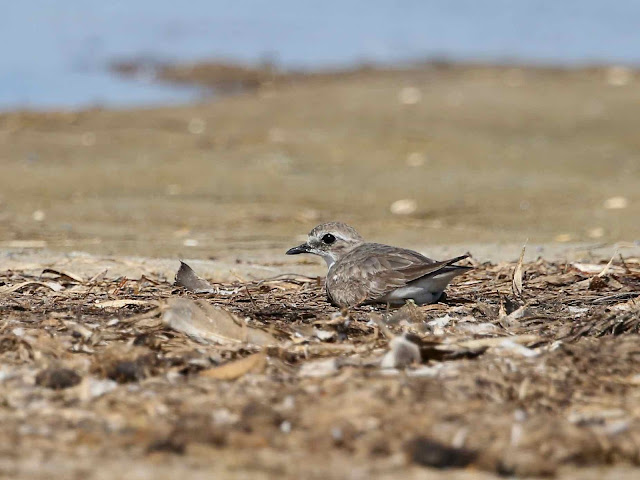One of the
advantages of conducting weekly surveys for beach nesting birds by boat across
a large area of the Gippsland Lakes (excluding the Lake Wellington end of the
Lakes) is that we can also record visiting migrant shorebirds including some
rare visitors to the Lakes.
On 18 December
2018 we picked up a lone Lesser Sand Plover (Charadrius mongolus) (1) in company with a couple of Red-capped
Plovers on Pelican Island. This sighting was reported to Eremaea Birdlines
Victoria where it received a highlight blue star rating.
Please click on photos to enlarge.
 |
| A rough shot of the Lesser Sand Plover plus one of the Red-caps on Pelican Island. |
A check of The Atlas of Australian Birds, The New Atlas of Australian Birds and BirdLife Australia’s Birdata site found no records for the Lesser Sand Plover on the Gippsland Lakes. There is just one sighting at nearby Lakes Tyers. So, it is possible that the bird found on 18 December is the first record for this species on the Gippsland Lakes.
We then
found another Lesser Sand Plover 21 days later, on Albiforns Island (near
Crescent Is) on 8 January 2019. This new site is approximately 9 kilometres
south west of the Pelican Is site. There is a very good chance that the two
sightings are of the same bird.
Another
Lesser Sand Plover sighting by Robert Wright at Crescent Island, (near Albifrons
Island) on 10 January 2019 and reported on Birdline Victoria, is likely to be
the same bird we found in December and again on 8 January.
Then on 15 January
we found the Plover again on Albifrons Island, this time in company with some
Red-necked Stints.
 |
| This photo shows the Lesser Sand Plover and our smallest migrant shorebird, the Red-necked Stint, together which allows a size comparison. |
 |
| The Lesser Sand Plover seemed relaxed and not concerned by our presence on the boat just off shore. |
 |
| A side-on photo of the Plover. |
 |
| Like most Plovers this bird has a relatively large eye. |
 |
| The Plover began to crouch. |
 |
| The Plover then laid down and stayed still in this position for about 15 seconds. |
 |
| Then the bird lifted its head. |
 |
| After about 50 seconds from first taking cover it stood up. |
Lesser Sand Plovers breed in far eastern Siberia, Mongolia and northern China. In their non-breeding plumage in Australia they could be mistaken for the similar looking non-breeding Greater Sand Plover, Double-banded Plover or a female Red-capped Plover.
When in the
field it is always worth looking carefully at small shorebirds, especially when
in small flocks, as you never know when an unusual visitor might turn up.
Taking photos of any unusual birds for checking/verifying ID with field guides
later is a good idea and if a rare species is found, a photo is essential for verification
of the sighting.
Note (1)
The name Lesser
Sand Plover (Charadrius mongolus)
comes about as follows:
Lesser is
by comparison with the very similar but slightly larger Greater Sand Plover.
Sand comes
from the sandy desert habitats where Sand Plovers prefer to breed.
And
mongolus from Mongolia where they can be found breeding.
Other names
include Mongolian Sand Plover, Mongolian Plover and Mongolian Dotterel.
Previously the name Dotterel was more widely applied in Australia to the smaller members of the Plover family but strangely the name Dotterel is still applied to Red-kneed and Black-fronted Dotterels even though they are actually plovers.
Previously the name Dotterel was more widely applied in Australia to the smaller members of the Plover family but strangely the name Dotterel is still applied to Red-kneed and Black-fronted Dotterels even though they are actually plovers.
No comments:
Post a Comment